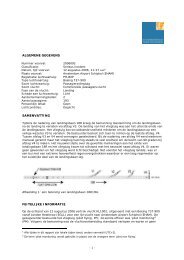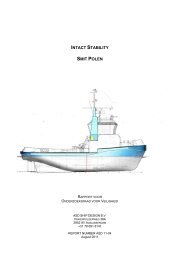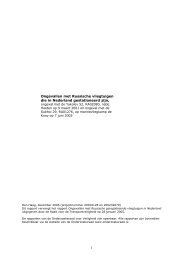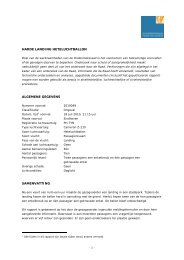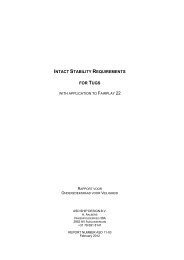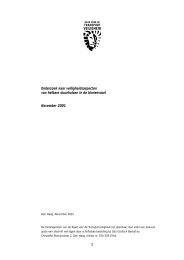Rejected takeoff after the takeoff decision speed 'V ', Boeing B737 ...
Rejected takeoff after the takeoff decision speed 'V ', Boeing B737 ...
Rejected takeoff after the takeoff decision speed 'V ', Boeing B737 ...
Create successful ePaper yourself
Turn your PDF publications into a flip-book with our unique Google optimized e-Paper software.
deciding to reject <strong>the</strong> <strong>takeoff</strong> is also not well trained. The study points out that <strong>the</strong> lack of reference<br />
as to what might make <strong>the</strong> aircraft unsafe to fly makes it difficult for crews in recognising such a<br />
situation to make an appropriate <strong>decision</strong>. It should be noted that care must be taken in comparing<br />
<strong>the</strong> positive (yes) and negative (no) <strong>decision</strong> to reject <strong>the</strong> <strong>takeoff</strong>. The undetermined reasons of<br />
correctness of <strong>the</strong> <strong>decision</strong> has increased in <strong>the</strong> period 1994-2008 versus 1980-1993.<br />
1980 - 1993<br />
1994 - 2008<br />
yes<br />
33,3%<br />
yes<br />
31,9%<br />
no<br />
50,8%<br />
no<br />
44,4%<br />
unknown<br />
15,9%<br />
unknown<br />
23,6%<br />
Figure 12: Correct <strong>decision</strong> to reject a <strong>takeoff</strong>. Source: NLR-TP-2010-177 NLR Air Transport Safety<br />
Institute 2010.<br />
5.5 REJECTED TAKEOFF DILEMMA<br />
In <strong>the</strong> past industry initiatives and studies have identified that rejected <strong>takeoff</strong>s are a high risk<br />
area. Analysis of available data highlighted that <strong>after</strong> V 1<br />
and V R<br />
a runway overrun is likely and<br />
could potentially result in aircraft damage and/or loss of life. Statistics fur<strong>the</strong>r show that <strong>the</strong> rate<br />
of rejected <strong>takeoff</strong> is declining. However <strong>the</strong> rate of high <strong>speed</strong> rejected <strong>takeoff</strong>s is not. In general<br />
past studies conclude that if procedures were followed <strong>the</strong> outcome would have been different.<br />
This conclusion it subsequently followed by <strong>the</strong> recommendation that flight crew should follow<br />
procedures and act accordingly.<br />
Despite simulator training on rejected <strong>takeoff</strong>s and instruction on <strong>the</strong> risks of (high <strong>speed</strong>) rejected<br />
<strong>takeoff</strong>s flight crews, when faced with a problem in reality, do not always react desirably and follow<br />
procedures. This is mainly due to <strong>the</strong> fact that during <strong>takeoff</strong> <strong>the</strong> interaction between <strong>the</strong> aircraft,<br />
environment and crew are tightly related. This interaction may result in a complex situation which<br />
is unfamiliar and difficult to assess.<br />
Technical monitoring and warning system were introduced into aircraft in <strong>the</strong> past which, when<br />
appropriate, would warn flight crew of a problem. This warning system monitors aircraft condition<br />
and should help flight crew in assessing situations correctly. In this event no warnings were triggered<br />
and <strong>the</strong> aircraft did not indicate <strong>the</strong>re was a problem. From a manufacture standpoint <strong>the</strong> aircraft<br />
was <strong>the</strong>refore airworthy and safe to fly. The control check performed before flight is, in part, to<br />
assess <strong>the</strong> aircraft state and verify control responses. The environmental conditions like snow and<br />
rain on a runway are addressed in manuals to help flight crew in determining aircraft performance<br />
and make adjustments. This information is used to set preconditions and determine <strong>decision</strong> <strong>speed</strong>s.<br />
The fact remains that despite aircraft monitoring and managing preconditions impacting aircraft<br />
performance unexpected situation may occur. On <strong>takeoff</strong> <strong>the</strong> flight crew rely on perception and<br />
interpretation of situations. This perception and interpretation provides opportunity for errors<br />
in <strong>decision</strong> making. Guidance, procedures and training should help pilots in <strong>the</strong> <strong>decision</strong> making<br />
process in <strong>the</strong> critical phase of flight. With <strong>the</strong> current state of technology and human factors<br />
<strong>the</strong>ories available, a re-evaluation of <strong>the</strong> rejected <strong>takeoff</strong> concept and procedures may be useful<br />
and warranted.<br />
25








